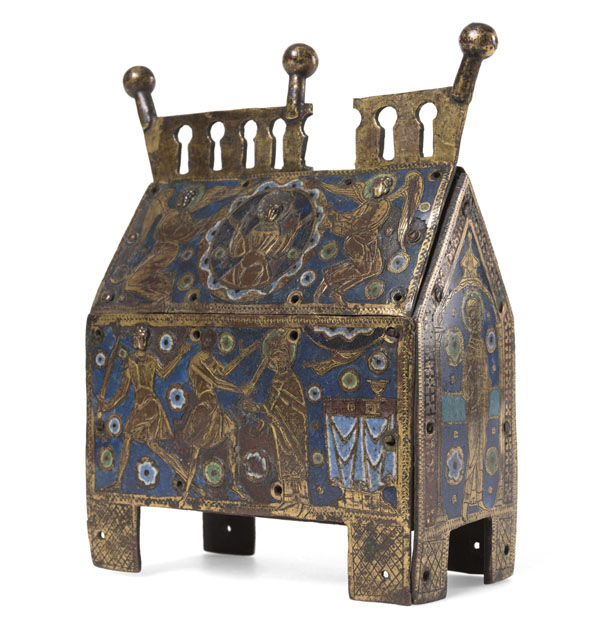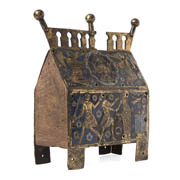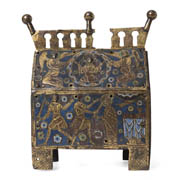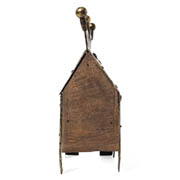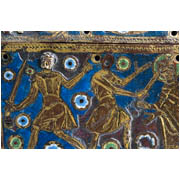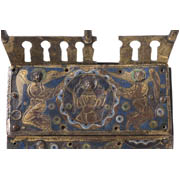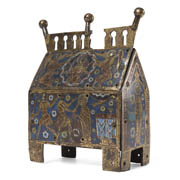Details
- Object type
chasse; reliquary casket
- Title
Limoges casket
- Place Associated
France, Limoges (place of manufacture)
- Date
circa 1200-1210
- Materials
champleve enamel, gilt copper, wood
- Dimensions
overall (with finial): 171 mm x 121 mm x 70 mm (approx depth); overall (without finial): 127 mm x 121 mm x 70 mm (approx depth) 820 g
- Description
-
Reliquary casket (or chasse) produced in Limoges, France, depicting the martyrdom of St Thomas Becket, Archbishop of Canterbury (1119 or 1120-1170).
A rectangular, house-shaped casket with gabled ends and an eave top, made of engraved and champlevé enamelled copper plaques fixed to a wooden core. A side and back panel (formerly the hinged opening) are missing, as is a section of roof cresting and the head of one of the assassins.
On the front, the haloed and mitred Becket stands below the Hand of God and turns towards his attackers. He is standing before a draped altar, on which stand liturgical items; the chalice, paten, book and pyx. Two knights complete the scene, one driving his sword through the head of St Thomas, while the other flees. The upper panel depicts the soul of the saint rising to Heaven with the aid of two angels. An unidentified mourning saint fills the side panel. The panel of the upper reverse is decorated with a double row of five, four-petalled flowers, within a border of crosses. The two remaining strips on the left and right of the lower reverse are decorated with partial rosettes. The enamels consist of the traditional colours associated with Limoges work, vivid light and dark blue, red, green, yellow and white.
Champlevé enamel goods were a speciality of the workshops of Limoges from the twelfth to the fourteenth century. An area already known for its talented goldsmiths, it came to dominate the production of enamelled wares, eclipsing other significant centres of production such as Cologne, Germany. The over 8000 known survivals are indicative of the great pan-European market for the candlesticks, boxes, book covers, and jewellery of Limoges that existed amongst both ecclesiastic and secular communities. Amongst the most notable survivals are reliquary chasses, of which some 700 are recorded. Over 50 of these depict the martyrdom of St Thomas Becket.
Becket’s murder at the hands of four knights, Reginald FitzUrse, Hugh de Moreville, William de Tracy and Richard le Breton (or Bret), possibly acting upon the direct orders of the King Henry II of England, shocked and appalled Christendom. Formerly close friends, King Henry appointed Becket to the archbishopric in the hope of securing an ally within the Church, who would act in his interests and the interests of royal authority. Becket’s unexpected piety and defence of the soured the relationship, culminating in his murder at Canterbury Cathedral, 29 December 1170.
After less than three years Becket’s sainthood was officially recognised by Pope Alexander III. His canonisation, on 21st February 1173, was one of the quickest achieved by any saint at the time.
Supported by the wide dissemination of relics from Canterbury, the cult of St Thomas was international in its scope and appeal. It is not known if Canterbury directly initiated the production of the Limoges caskets, but it is likely that at least a number of these pieces were used in the gifting and transfer of Becket’s relics, perhaps fragments of bone or strips of clothing dipped in the saint’s blood, from Canterbury to religious houses throughout Europe.
Burrell acquired this casket from Leopold Hirsch in 1934, but it had also been owned by collectors Walter Sneyd and Horace Walpole (Strawberry Hill sale catalogue 1842, p.137, no.83). Excitingly, the reliquary can be traced back even further through Thomas Barrett of Lee Priory, near Canterbury, to John Batteley (or Battely), Archdeacon of Canterbury Cathedral (1646-1708), where Becket’s shrine attracted countless pilgrims before its destruction by Henry VIII in 1538.
This reliquary was first noted and drawn at Walpole's Strawberry Hill by the Cambridgeshire clergyman and antiquary William Cole in 1792 (see British Museum, Manuscript Collection, Add. MS.5841.149, p.151.)
- Credit Line/Donor
Gifted by Sir William and Lady Burrell to the City of Glasgow, 1944
- Collection
Burrell Collection: Limoges, Enamels, Copper-Gilt items, etc
- ID Number
26.6
- Location
Burrell Collection
- Related People
Leopold Hirsch owner
Walter Sneyd owner
Horatio Walpole owner
Thomas Becket subject of
